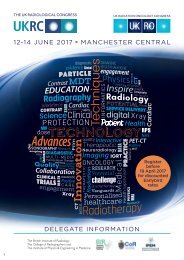Towards Safer Radiotherapy
Towards Safer Radiotherapy
Towards Safer Radiotherapy
Create successful ePaper yourself
Turn your PDF publications into a flip-book with our unique Google optimized e-Paper software.
Chapter 4: Prerequisites for safe delivery<br />
of radiotherapy<br />
Patients undergoing radiotherapy expect the best possible care with the minimum risk of sideeffects<br />
or complications. The balance between disease control and side-effects means that<br />
treatment should only commence after a detailed consultation with the patient, leading to explicit<br />
consent to treatment. 48–50<br />
In addition, it is incumbent on organisations providing radiotherapy and on all the professional staff<br />
involved in its delivery to ensure that this delicate balance is not adversely affected by errors and<br />
untoward incidents in any part of the delivery process. This chapter addresses the prerequisites for<br />
the safe delivery of service and reviews the recommendations that contribute to this overall<br />
objective.<br />
4.1 <strong>Radiotherapy</strong> services are complex and dynamic<br />
24<br />
Complexity arises from the wide range of conditions treated, technologies used and professional<br />
expertise needed. This complexity is compounded by the fact that processes are dynamic,<br />
continually changing in the light of research and the introduction of new technologies. Complexity<br />
and change increases the probability of incidents and errors reinforcing the need to design delivery<br />
systems which, as far as possible, ensure safety and efficacy.<br />
Safe radiotherapy depends on:<br />
• An adequately trained professional workforce practising together in a multidisciplinary<br />
environment<br />
• Robust operational and management systems which facilitate safe and effective practice<br />
• Equipment which is designed with safety in mind and which is up to date and maintained to<br />
high standards.<br />
4.2 Workforce<br />
4.2.1 The professional workforce directly involved in the delivery of radiotherapy includes, for<br />
example, clinical oncologists, therapeutic radiographers, clinical scientists and clinical<br />
technologists. Tasks should be assigned in relation to competency rather than professional<br />
background, so as to maximise the benefits of skills mix. 51 More details of the training and<br />
qualifications required can be found by referring to professional organisations and regulatory<br />
bodies. 52–54<br />
4.2.2 In addition to the achievement of core qualifications, competence to practise in a particular<br />
centre depends on specialised training in local procedures and practices. There is<br />
considerable diversity in operational practice and equipment throughout the UK and<br />
internationally. This diversity is one of the drivers for local training.<br />
4.2.3 Following initial attainment of competence, all professional staff need to maintain their skills<br />
by lifelong learning through continuing professional development (CPD), which is a<br />
requirement for the maintenance of registration in most regulatory frameworks.<br />
Maintenance of competency is particularly important in radiotherapy due to the fast pace of<br />
change as new techniques and equipment are introduced. Training should include safety<br />
aspects, learning from radiotherapy incidents and quality assurance methodology. This<br />
should form an essential part of CPD. The maintenance of up-to-date training records is<br />
essential as is adequate funding for staff training.<br />
<strong>Towards</strong> <strong>Safer</strong> <strong>Radiotherapy</strong>



